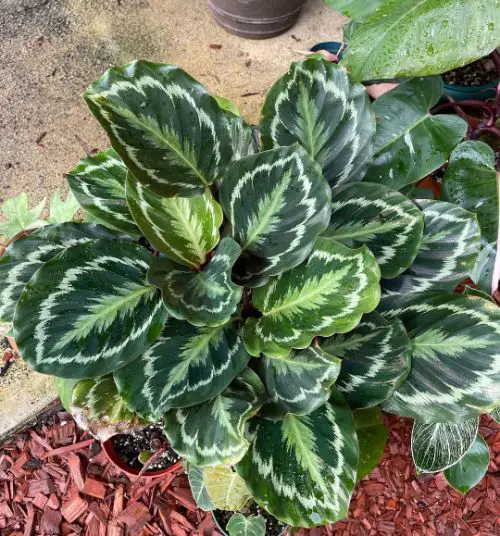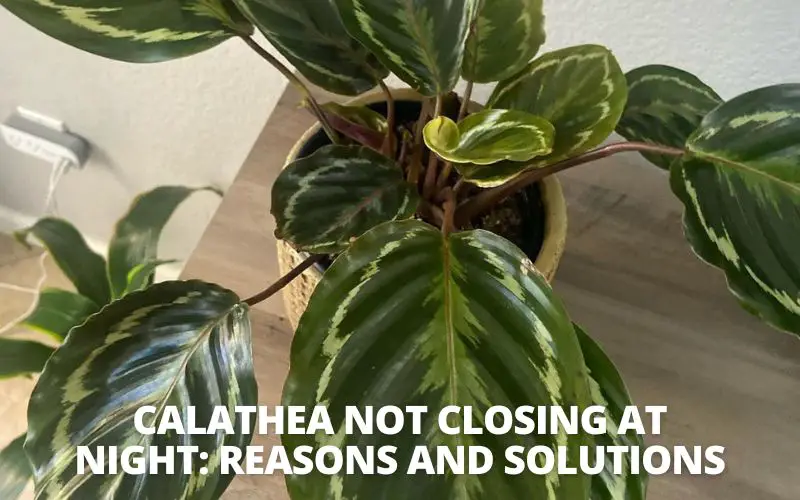Do you have a Calathea that isn’t closing its leaves at night? If so, don’t worry, you’re not alone. There are several reasons why this might happen, and fortunately, there are several solutions.
This blog post will discuss the possible causes of Calathea not closing at night and how to correct them. We will also provide some tips on how to care for your Calathea so that it stays healthy and happy.
Why is my Calathea not closing at night?
Several reasons your Calathea might not be closing its leaves at night. The most common cause is that the plant is not getting enough light. Calatheas need bright, indirect sunlight to thrive, so if yours isn’t getting enough light, it could be why it’s not closing its leaves at night.
Another possible reason is that the plant is too dry. Calatheas need to be kept moist, so if the soil is too dry, the leaves will not close. Finally, it could be that the temperature is too cold. If the temperature drops below 60 degrees Fahrenheit, the Calathea will not close its leaves.
Do all Calatheas close at night?
Most Calatheas close at night, but there are a few exceptions. The plant known as Calathea Veitchiana, for instance, is commonly known as the “praying mantis” plant because its leaves fold together in a way that resembles the posture of a praying mantis.
Another exception is the “medallion” Calathea (Calathea medallion), which gets its name from the fact that its leaves are often used as decoration in homes and gardens. While most Calatheas close at night, these two species are just two of the many exceptions to this rule.

Calathea Veitchiana not closing at night
Calathea Not Closing at Night: A Guide to Solving the Problem
If your Calathea isn’t closing its leaves at night, don’t worry! There are several reasons why this might happen, and fortunately, there are several solutions. We will also provide some tips on how to care for your Calathea so that it stays healthy and happy!
1. Overwatering
One of the most common reasons why a Calathea plant might not be closed at night is because it is overwatered. Overwatering can cause the leaves to become limp and discolored, preventing the plant from getting the oxygen it needs to survive.
Solutions:
- Examine the roots of the Calathea by removing them from the pot. Use sterile pruners to remove any roots that are brown and mushy
- Fungicide should be sprayed on the healthy roots
- Give the plant a new pot with drainage holes and repot it
- Repot your Calathea using brand-new potting soil that drains properly
- Keep your Calathea in a room with lots of bright, indirect light
- Only water when the top two inches of soil are dry
- Mark the plant if it exhibits any overwatering indications, such as yellowing or drooping leaves
You may also like: Why is my Calathea turning yellow and how to fix them
2. Underwatering
Calathea does not tolerate drought conditions, therefore it will suffer if not given enough water.
If you ignore the warning signals and continue to give your Calathea less water, it will get dehydrated and the leaves will begin to dry out. As a result, your Calathea leaves may not close up at night.
A submerged Calathea will exhibit the following characteristics:
- Wilted leaves
- Dry leaves
- Brown leaves
- Droopy leaves
- Plant dehydrated
Solutions:
- Water the soil and wait a few seconds for it to soak up the water
- By poking holes in the soil with a chopstick, you may aerate it. This allows the soil to absorb water more efficiently
- Water your Calathea thoroughly once it has soaked in water until the water begins to run out of the drainage openings
- Keep an eye on the soil to see when the top layer has dried off. When the plant dries up, water it immediately
- If you don’t have time to water the plant, choose a self-watering pot
3. Temperature
If the temperature is too cold, the Calathea will not close its leaves. Calatheas like warm weather and prefer temperatures between 60-85 degrees Fahrenheit. If the temperature drops below 60 degrees Fahrenheit, move your Calathea to a warmer location.
Signs Your Calathea plant isn’t growing at the right temperature:
- Overwatering or underwatering can also create limp or drooping leaves
- Loss of color or pattern, particularly if leaves darken rather than lighten
- Slow development and a deficiency of fresh leaves
- Leaf drop if the temperature drop is substantial or prolonged
When the issue is a lack of humidity, Calathea plants display symptoms such as:
- Crispy brown margins on elder leaves suggest under-watering as well as a lack of moisture in the air.
- Wilted leaves that do not respond to temperature increases
- Soil rapidly dries between waterings, making it difficult to maintain an appropriate amount of moisture.
- Slow growth
- Pale leaves with no color or pattern
Solutions:
- Determine the direction from which the plant is receiving chilly drafts. Bring it a few feet away from the window if it is too close
- Keep them away from the ceiling fan so that the fan’s air does not touch the plant
- Some homes have air conditioners. If your Calathea is in such a room, consider relocating it to another room with no air conditioning. Alternatively, keep it away from the air conditioner so that the cold air does not touch or impair Calathea’s health
- When your Calathea is exposed to chilly drafts, do not place it near any heating devices. Bringing the plant next to any heating equipment would only make matters worse
- Calathea needs time to acclimate to her new surroundings. A sudden shift might startle the plant. Try gradually shifting the plant’s placement. It will slowly adapt to its new surroundings
- The plant will require less water if exposed to cold conditions
4. Low light
Calatheas need bright, indirect sunlight to thrive. Calatheas are native to tropical forests, where they are found to grow on the ground under huge canopies that let in dappled light.
Although these plants can tolerate low light conditions, a protracted period of low light will impair their normal operations. Because of this, if your Calathea is put in a low-light area, its leaves could not close at night.
Signs of low light Calathea
- Leaves that are discolored
- Growth has been slowed
- Leggy development
- Weak plant
Solution:
- Move your Calathea to a brighter spot and make sure it’s getting at least six hours of indirect sunlight per day
- Remove any discolored leaves or unhealthy growths
- If your home does not receive enough natural light, utilize artificial lights known as grow lights
You may also like: Calathea light requirements: How much light do they need?
5. Direct sunlight
Calatheas can survive in tolerate but not in direct sunshine. Calathea, like most other houseplants, is susceptible to direct sunlight.
If you position your Calathea in direct sunlight, its leaves will become burnt and not function properly. As a result, you may not notice the regular movements, such as stopping close at night.
The following symptoms indicate a burnt Calathea:
- Soil that is dry and compact
- charred leaves
- Dry brown spots on the leaves
- Plant that is dehydrated and dull
Solutions:
- If your plant is on the balcony or patio and receives direct sunshine, bring it inside. You may also relocate it to a more shady location
- Remove any burned or diseased leaves
- If you install the Calathea near a window, you may relocate it a few feets or use filters or shutters to block direct sunlight
- Make sure that the plant receives adequate darkness. Calatheas require eight hours of the night every day
6. Low humidity levels
If the air in your home is too dry, it could be the reason why your Calathea’s leaves are not closing at night. Calatheas prefer high humidity levels, so if the air in your home is dry, try to increase the humidity around the plant. You can do this by placing a humidifier near the Calathea or misting the leaves with water. We recommend the best humidifier For Calathea, it is LEVOIT Humidifiers for Bedroom Large Room Home.

7. Pest infestation
Pest infestation is another possible reason for Calathea not closing at night. If your Calathea has pests, the leaves will not close properly.
The most common pests attacking a Calathea plant are common houseplant pests such as spider mites and aphids.
Spider mites will produce webbing of the leaves, causing damage to the leaf tissue and preventing Calathea leaves from moving.
They can be found by attentively inspecting the leaf surface. They’ll appear as little black dots.
And the aphids drain the cell sap, and Calathea will be unable to function correctly due to a shortage of nutrition, causing leaf deformation. They are both detrimental to your Calathea plant.
Signs of pest on your plant:
- Leaves with holes
- Flimsy and boring plant
- Uneven leaves
- under the leaves, formations like webs
- Spotted leaves
Solutions:
- the pests, wipe the diseased leaves with a wet cotton ball
- Cover your Calathea with neem oil
- Any ready-to-use organic pesticide you may also be sprayed
- Provide the Calathea with enough water and light, and make sure all other circumstances
We hope this blog post helped troubleshoot why your Calathea not closing at night. If you have any other questions about Calatheas or plant care, feel free to reach out to us! We’re always happy to help. Thanks for reading.


